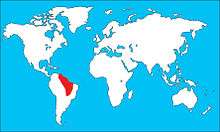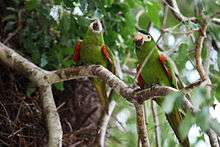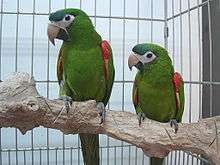Red-shouldered macaw
| Red-shouldered macaw | |
|---|---|
| | |
| Hahn's macaw (D. n. nobilis) | |
| Scientific classification | |
| Kingdom: | Animalia |
| Phylum: | Chordata |
| Class: | Aves |
| Order: | Psittaciformes |
| Superfamily: | Psittacoidea |
| Family: | Psittacidae |
| Subfamily: | Arinae |
| Tribe: | Arini |
| Genus: | Diopsittaca Ridgway, 1912 |
| Species: | D. nobilis |
| Binomial name | |
| Diopsittaca nobilis Linnaeus, 1758 | |
| Subspecies[2] | |
|
D. n. cumanensis (Lichtenstein 1823) | |
 | |
| Distribution across South America | |
| Synonyms | |
|
Ara nobilis | |
The red-shouldered macaw (Diopsittaca nobilis) is a small green South American parrot, a member of a large group of Neotropical parrots called macaws. The species is named for the red coverts on its wings. It is the smallest macaw, being 30–35 cm (12–14 in) in length. It is native to the tropical lowlands, savannah, and swamplands[3] of Venezuela, the Guianas, Bolivia, Brazil, and far south-eastern Peru. It has two distinct subspecies, the noble macaw and the Hahn's macaw, and a possible poorly distinct third subspecies that has longer wings, but is otherwise similar to the noble macaw. Red-shouldered macaws are frequently bred in captivity for the pet trade, where they are sometimes described as mini-macaws.
Though wild populations of red-shouldered macaws have declined locally due to habitat loss, they are listed as Least Concern by IUCN. They are listed on Appendix II of CITES, trade restricted.
Taxonomy
The red-shouldered macaw (Diopsittaca nobilis, Linnaeus, 1758) is a member of the monotypic genus Diopsittaca (Ridgway 1912), one of 6 genera of Central and South American macaws. There are two distinct subspecies, D. n. nobilis (Hahn's macaw) and D. n. cumanensis (noble macaw), and some with longer wings might represent a poorly differentiated subspecies, D. n. longipennis, which intergrades with D. n. cumanensis in central Goiás, Brazil.[4] Previously the red-shouldered macaw was included in the genus Ara.
Description

The red-shouldered macaw, at 30 cm (12 in) long and 165 g (5.8 oz) weight, is the smallest of all the macaws. Like all macaws, it has a long narrow tail and a large head. It has bright green feathers on the body, with dark or slate blue feathers on the head just above the beak. The wings and tail have feathers that are bright green above and olive-green below. The leading edges of the wings, especially on the underside, are red. (These red feathers appear at puberty.) Their eyes are orange, and the skin around the eyes is white without feathers, just as in the larger macaws. This bare patch of facial skin is smaller in proportion to the head than the one seen in most larger macaws. The Hahn's macaw and noble macaw can be distinguished by the Hahn's having a black upper mandible and the Noble having a lighter, horn-colored upper mandible.
Their natural vocalizations are more akin to screeches than they are to whistles.[5]
Behavior
Red-shouldered macaws are very kind natured, and have similar characteristics of a conure.
Breeding


The red-shouldered macaw nests in a hole in a tree. There are usually three or four white eggs in a clutch. The female incubates the eggs for about 24 to 26 days, and the chicks fledge from the nest about 54 days after hatching.[6]
References
- ↑ BirdLife International (2012). "Diopsittaca nobilis". IUCN Red List of Threatened Species. Version 2013.2. International Union for Conservation of Nature. Retrieved 26 November 2013.
- ↑ "Zoological Nomenclature Resource: Psittaciformes (Version 10.022)". www.zoonomen.net. 29 August 2010.
- ↑ Online Book of Parrots - Genus Diopsittaca
- ↑ Forshaw (2006). plate 73.
- ↑ "Red-shouldered Macaw".
- ↑ Alderton, David (2003). The Ultimate Encyclopedia of Caged and Aviary Birds. London, England: Hermes House. p. 237. ISBN 1-84309-164-X.
Cited texts
- Forshaw, Joseph M. (2006). Parrots of the World; an Identification Guide. Illustrated by Frank Knight. Princeton University Press. ISBN 0-691-09251-6.
External links
| Wikimedia Commons has media related to Diopsittaca nobilis. |
